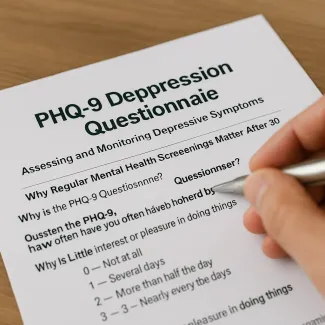
Understanding the Value of the PHQ-9 in Everyday Mental Health Awareness
Why Regular Mental Health Screenings Matter After 30
Mental health is a fundamental part of overall wellbeing, yet it is often overlooked until symptoms become disruptive. As we move through different life stages, especially after 30, the pressures of career, family, financial stability, and physical health changes can all contribute to increased stress and emotional challenges. The PHQ-9 Depression Questionnaire is a scientifically validated tool designed to help individuals and clinicians identify early signs of depression and monitor symptom progression over time. Its simplicity, reliability, and accessibility make it an essential part of modern mental health care.
What Is the PHQ-9 Questionnaire?
The PHQ-9 (Patient Health Questionnaire-9) is a self-administered tool consisting of nine questions, each relating to a core symptom of depression as defined by the Diagnostic and Statistical Manual of Mental Disorders (DSM). The questionnaire provides both a diagnostic and monitoring function, allowing for repeated use to track changes in symptom severity.
A Quick Overview of the PHQ-9 Items
Each item of the PHQ-9 corresponds to one of the following symptoms of depression:
Loss of interest or pleasure in doing things
Feeling down, depressed, or hopeless
Trouble falling or staying asleep, or sleeping too much
Feeling tired or having little energy
Poor appetite or overeating
Feeling bad about yourself — or that you are a failure
Trouble concentrating on things
Moving or speaking slowly or being fidgety and restless
Thoughts of self-harm or feeling better off dead
Users are asked to score the frequency of these experiences over the past two weeks using a 0–3 scale:
0 – Not at all
1 – Several days
2 – More than half the days
3 – Nearly every day
When and Why to Use the PHQ-9
Mental Health Check-Ups in Adulthood
Once we reach our 30s, the accumulation of life responsibilities often coincides with an increase in mental fatigue, emotional dysregulation, and chronic stress. Using the PHQ-9 on a regular basis can be a proactive approach to noticing subtle shifts in your mental wellbeing before they become severe.
Who Should Use the PHQ-9?
Individuals who want to track their own mood and emotional wellbeing
Primary care providers looking for a standardized way to evaluate mood symptoms
Therapists and counselors for intake evaluations and progress tracking
Workplace wellness programs as part of periodic assessments
How to Interpret PHQ-9 Scores
Severity Scale
The total score from all nine items helps determine the severity of depressive symptoms:
0–4: Minimal or no depression
5–9: Mild depression
10–14: Moderate depression
15–19: Moderately severe depression
20–27: Severe depression
A score of 10 or more is commonly used as a cutoff for potential clinical depression, but context and other symptoms should always be considered.
Practical Tips for Using the PHQ-9 Effectively
Tip 1: Use It as a Journal Tool
Incorporate the PHQ-9 into your weekly or bi-weekly reflections. This can help you connect emotional patterns with lifestyle events, habits, or environmental changes.
Tip 2: Share Results with Professionals
If you're experiencing troubling symptoms or high scores, bring your completed PHQ-9 to a mental health professional. It gives them a valuable snapshot of your current state and can help speed up accurate diagnosis and treatment planning.
Tip 3: Track Progress Over Time
Use a printable or digital copy regularly and chart your results. Tracking changes across weeks or months allows you to visualize improvement or worsening, empowering better decision-making around mental health.
How Employers and Organizations Can Implement the PHQ-9
Employee Mental Health Programs
Introducing the PHQ-9 into wellness programs or annual health assessments can be a low-cost, high-impact measure. It creates a foundation for early identification and referral to appropriate services, improving workplace morale and productivity.
Schools and Universities
For students, especially in higher education, stress, isolation, and academic pressure can exacerbate depression. The PHQ-9 can be a part of student support services to catch mental health concerns early.
Common Misconceptions About Depression Screening
"You Only Take It If You’re Depressed"
In truth, the PHQ-9 is most useful before symptoms reach a crisis point. Taking it when feeling “off” can help uncover hidden patterns of mood changes.
"It’s a Substitute for Diagnosis"
While the PHQ-9 is a powerful screening and tracking tool, it is not a replacement for clinical evaluation. It serves best when integrated into professional mental health care.
Integrating PHQ-9 into a Healthy Lifestyle
Using the PHQ-9 doesn't need to be a clinical activity. It can become part of a monthly self-check, much like tracking steps, sleep, or calories. Combined with exercise, good nutrition, adequate rest, and social support, it's a small step that supports a much larger commitment to long-term emotional wellbeing.
Depression is one of the most common yet treatable mental health conditions, and the earlier it’s identified, the better the outcomes. The PHQ-9 gives people an opportunity to understand themselves better, to start conversations, and to take control over their mental wellness.
By making this simple tool part of everyday life, you not only enhance your own resilience but also help normalize mental health care in your family, workplace, and community.





